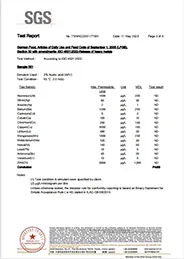
treating cast iron skillet
Treating and Caring for Your Cast Iron Skillet
Cast iron skillets have long been revered in kitchens around the world for their durability, heat retention, and versatility. Unlike non-stick pans, a well-seasoned cast iron skillet can enhance the flavor of your dishes while providing a naturally non-stick surface. However, to maintain and treat your cast iron skillet properly, it is essential to understand the nuances of seasoning, cleaning, and storage.
The Importance of Seasoning
Seasoning is the process of applying oil to the skillet and heating it to create a natural non-stick surface and protect the cast iron from rust. The first seasoning usually occurs during manufacturing, but if your skillet is new or has become less effective over time, it’s crucial to re-season it before use.
To season your skillet, start by washing it with mild soap and warm water to remove any factory residues. Once cleaned, dry the skillet thoroughly. Next, apply a thin layer of cooking oil (flaxseed oil, vegetable oil, or shortening are ideal) all over the skillet, including the outside and handle. Place the skillet upside down in an oven preheated to 450°F (232°C) for about an hour. This method allows the oil to polymerize, forming a hard and protective layer. After an hour, turn off the oven and let the skillet cool inside. Repeat this process several times for optimal seasoning.
Cleaning Your Skillet
One of the most common misconceptions about cast iron skillets is that they cannot be washed with soap. In reality, using a small amount of soap occasionally won’t strip away the seasoning, especially if the seasoning is well established. After each use, you should clean your skillet while it’s still warm. Scrape off any food remnants with a spatula or a specialized cast iron brush. For stuck-on food, you can sprinkle coarse salt on the surface and scrub with a paper towel or cloth.
Rinse your skillet under hot water and dry it completely. It’s vital to dry the skillet promptly, as any moisture can lead to rust. To ensure it’s completely dry, you can put it on a low heat burner for a few minutes, just to evaporate any left-over water. After drying, applying a light coat of oil helps maintain the seasoning and adds a layer of protection.
treating cast iron skillet

Storage Tips
Proper storage of your cast iron skillet is essential for its longevity. Storing the skillet in a humid environment can lead to rust, so consider placing it in a dry, well-ventilated area. If you stack your skillet with other cookware, consider placing a paper towel in between to absorb moisture and prevent scratching the seasoning.
Cooking Techniques
Cooking with a cast iron skillet is an enjoyable experience, but it may require some adjustments if you are used to non-stick cookware. Always preheat your skillet before adding oil or food; this helps create that sought-after sear and prevents sticking. When cooking, use medium to high heat, as cast iron retains and distributes heat evenly. Foods like cornbread, frittatas, and steaks can turn out beautifully if cooked properly.
Reviving a Damaged Skillet
If your cast iron skillet has lost its seasoning or developed rust, don’t despair. You can revive it! Start by scrubbing the affected areas with steel wool to remove rust. Next, wash, dry, and season it as described above. With patience, your skillet can regain its original glory.
Conclusion
A cast iron skillet is not just another kitchen tool; it is an investment that can last a lifetime if treated correctly. By seasoning your skillet regularly, cleaning it carefully, storing it properly, and using it effectively, you can enjoy the unmatched flavors and health benefits that come with cooking in cast iron. Embrace the tradition of cast iron cooking and watch as your meals reach new heights of deliciousness!
-
High Quality Cast Iron Pancake Crepe Pan - ZD Cookware | Durable, Non-Stick, Wooden HandleNewsJul.13,2025
-
High Quality Cast Iron Cookware - ZD Cookware|Durable Heat Retention&Non-Stick SurfaceNewsJul.13,2025
-
Cast Iron Pancake Crepe Pan-Durable Kitchenware-ZD CookwareNewsJul.13,2025
-
Premium Cast Iron Cookware ZD Cookware|Durable Non-Stick Wooden HandleNewsJul.13,2025
-
Durable Cast Iron Pancake Crepe Pan - Zhejiang ZD Cookware Co., Ltd.|Heat Retention,Durability,Non-Stick Surface,Versatile Cooking,Wooden HandleNewsJul.12,2025
-
High Quality Cast Iron Cookware - ZD Cookware | Black Pancake Pan, Non-Stick SurfaceNewsJul.12,2025


